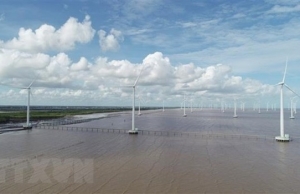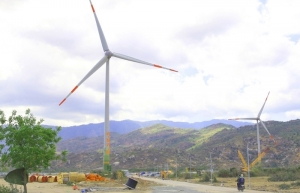Vietnam’s crucial role in the global energy transition and tackling climate change
The Kyoto Protocol adoption in 1997 was considered a historic turning point because it was the first global agreement on reducing anthropogenic emissions of greenhouse gases (GHGs) and setting obligations to reduce such emissions for developed countries. Then, at COP21 in 2015, all participants agreed to limit the average global temperature increase to below 2°C, and ideally 1.5°C, compared to pre-industrial levels.
 |
| Nguyen Anh Dung, senior officer at the Renewable Energy and Energy Efficiency Project under German development agency GIZ |
At COP26 last year, nearly 200 countries adopted the Glasgow Climate Pact to rapidly and sustainably reduce carbon emissions, including a 45 per cent reduction in carbon emissions by 2030. Nearly 100 countries have pledged to cut methane emissions by 30 per cent below 2020 levels by 2030. Forty countries, including Vietnam, have committed to cease development of and gradually phase out coal-fired power – which accounted for about 37 per cent of the total world electricity in 2019 and is a massive source of CO2 emissions.
The energy sector accounts for nearly three-quarters of global GHG emissions. Therefore, the sector is key in the emission reduction policies of countries around the world, especially the power and transport sectors. The transition from traditional to cleaner forms of energy in many countries was promoted early on, and accelerated significantly since 2000 to fulfil commitments on combating climate change as well as to ensure national energy security.
According to the International Renewable Energy Agency’s energy transition scenario to 2050, electricity will account for more than half of total final energy consumption by 2050, more than double that of today. Renewable energy will account for 86 per cent of the global electricity supply.
On a global scale, the total installed capacity of wind power in 2021 reached 837GW (with 94GW installed in 2021 alone) and the total installed solar capacity now exceeds the stunning total of 1TW, with over 183GW of new solar capacity installed in 2021. With solar and wind power now among the lowest cost sources of new power generation worldwide, this trend is expected to reshape power systems worldwide and increase the need for greater power system flexibility.
Electricity from renewable sources (including large hydropower station) now accounts for approximately one-quarter of the total global electricity supply. In addition, the sale of new electric vehicles in the world market doubled in 2021 to reach 6.6 million vehicles, bringing the total number of e-cars on the road worldwide to 16.5 million, three times more than in 2018.
Key role of insurance groups
The global energy crisis has provided a wake-up call to the world to reduce dependence on imported fossil fuels by renewable energy and energy demand management.
On a positive note, the crisis has positive impact on the power market as renewable energy-based electricity will become the main of energy security. Many policies are underway to accelerate the deployment of onshore wind, offshore wind, and solar.
Solutions have been found in many countries for challenges in energy transition, such as the integration of a large share of variable renewable energy into the power system. Countries such as Ireland, Denmark, the UK, and parts of Germany and Portugal have shown that renewable energy sources can power local and national power systems for days, weeks, even months. However, this leads to supply chain challenges that need to be addressed.
Global insurance companies are playing a vital role in global financial trends. Without insurance, there is no credit for project development.
Due to business orientation, political factors, and pressure from shareholders, an increasing number of insurance companies have announced or plan to stop providing insurance for fossil fuels. More than 20 companies, representing one-fifth of the insurance industry’s global assets, have left the coal business.
Meanwhile, 43 per cent of the reinsurance market is limited to coal-based generation, including companies such as Swiss Re and Munich Re as well as other insurers and reinsurers such as Allianz, AXIS Capital, Generali, Hannover Re, and Zurich Insurance.
Perhaps, actions from insurers are the most accurate indicator of a fundamental decline in coal credit to cause enormous hardship for coal-dependent countries.
Vietnam started the energy transition early with the promulgation of avoided costs tariffs for renewable energy in 2008 and the feed-in tariff (FiT) for wind power in 2011.
Lately, Vietnam has successfully expanded investment into wind and solar power projects by using strong incentives based on an FiT mechanism.
In general, Vietnam’s energy policy is implemented and perfected through energy and sub-sector development strategies which create a general legal framework for the energy industry and are in line with Vietnam’s socioeconomic development goals in different periods.
Environmental emphasis
To meet the requirements of national energy development in the new context and conditions, in 2020 the Politburo issued Resolution No.55-NQ/TW on the orientation of Vietnam’s national energy development strategy to 2030, with a vision to 2045.
The document raised five groups of goals and 10 main groups of tasks and solutions, which focus on the requirement of ensuring national energy security – a crucial precondition for socioeconomic development – building an energy market quickly and transparently and applying market prices to all forms of energy in the country.
The resolution places emphasis on the need for environmental protection and the economical and efficient use of energy as important national policies and societal responsibilities. Regarding the energy structure, the resolution clearly states the necessity of synchronous and rational development and diversification of energy types.
Vietnam’s commitment at COP26 was highly appreciated by the international community. Many countries, international organisations, and development partners have committed and proposed to cooperate to implement this commitment.
Immediately after COP26, the prime minister directed ministries and branches to develop programmes to implement Vietnam’s commitments. The government has established a National Steering Committee, headed by the PM.
In July, the prime minister also issued Decision No.896/QD-TTg approving the National Strategy on Climate Change to 2050. This is the legal form of commitment to a net zero target and stated, “Climate change adaptation and implementation of net-zero emissions are an opportunity for sustainable development and the highest priority.”
Vietnam’s emission targets have been calculated and given specific milestones for each sector. By the end of the decade, renewable energy – including hydroelectricity, wind power, solar power, and biomass – shall account for at least a third of the produced electricity.
By 2050, renewable energy in Vietnam shall account for at least 55 per cent of all total electricity produced.
 | Southeast Asia’s information platform for energy transition debuts A regional information platform for energy transition SIPET, targeted at professionals, has been launched by the Clean, Affordable, and Secure Energy for Southeast Asia (CASE) to facilitate dialogue and promote coordination in the region’s power sector to support the acceleration of the energy transition in the region. |
 | Meeting Southeast Asian capital and energy needs With changes in capital markets coming to the forefront of executive agendas, Bain & Company and our partner Rivel, a research firm, recently interviewed 89 investors and analysts about how the energy transition is shaping investment decisions in the energy sector. We found that the transition is squarely at the centre of the agenda for investors, and it shapes perspectives on individual companies and sectors. As a result, the to-dos for executive teams in utilities and in oil and gas are very different. |
What the stars mean:
★ Poor ★ ★ Promising ★★★ Good ★★★★ Very good ★★★★★ Exceptional
Related Contents
Latest News
More News
- Swedfund invests in MSME growth and climate action in Vietnam (December 19, 2025 | 11:42)
- GreenYellow brings solar energy to light up remote schools in Tuyen Quang province (December 19, 2025 | 08:00)
- Charge+, Grab partner to develop EV charging network in Vietnam (December 18, 2025 | 17:11)
- Linking sci-tech and innovation to Vietnam’s net-zero future (December 18, 2025 | 14:31)
- Driving double-digit growth through green and circular transformation in Vietnam (December 17, 2025 | 09:00)
- Standard Chartered and ACCA deepen collaboration to develop Vietnam’s talent for a sustainable future (December 15, 2025 | 18:18)
- Schaeffler reports strong early output from Dong Nai solar project (December 12, 2025 | 15:16)
- Forestry conference highlights biodiversity and sustainability goals (December 09, 2025 | 13:35)
- Home Credit honoured among top 10 sustainable companies in trade and services (December 09, 2025 | 12:18)
- SCG and seven member companies honoured in Top 100 Sustainable Businesses 2025 (December 08, 2025 | 09:00)

 Tag:
Tag:


















 Mobile Version
Mobile Version